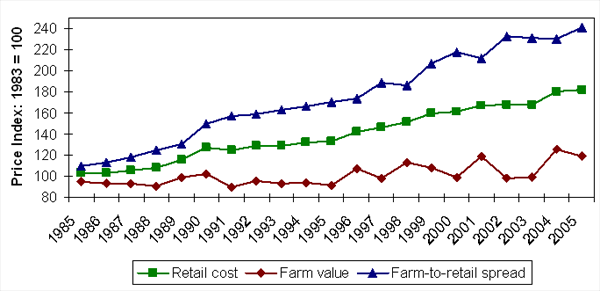Chad Dechow
Assistant Professor of Dairy Cattle Genetics
Department of Dairy and Animal Science
The Pennsylvania State University
The evil “Big Oil” companies are under threat of legislation and Congressional investigation for profiteering because they dare to make an entire 9 to 10 pennies per gallon of gasoline. Imagine the fun Congress could have with the folks selling rbST-free milk. For a mere dollar or two extra, you can now buy a gallon of milk from cows not treated with rbST. Only don’t pretend you’re helping out the hard working farmers who milk non rbST-treated cows. They will receive little or none of that premium.
Dairy producers are obviously not happy. The consumer-farmer price disparity is easy to spot with rbST-free milk, but this disparity is simply a time condensed and dramatic example of the long-term trend. USDA keeps track of trends in farm and consumer prices and the appalling rbST-free milk marketing gimmicks motivated me to dig up the numbers. Through the early 1980’s, farmers typically received 50% of the retail dollar. Today’s farmer will only pull in around 30% of the retail dollar.
Genetics, biotechnology, and evolving management practices have helped make our dairy farms more efficient, but that efficiency is not being passed to consumers. Retail prices have gone up at essentially the rate of inflation while the price paid to farmers has remained stagnant. The farm-to-retail price spread increased 241% from 1983 to 2005 (see Figure 1). Many dairy producers have lost the farm they’ve poured their life into because they could no longer pay their bills in such an environment. Cows lose in this deal as well. The constant drive toward greater farm efficiency makes proper stewardship of the creatures we care for that much more difficult.
Lower consumer prices for dairy products was one of the promises technologies like rbST were to deliver. So how has the consumer made out after approval of rbST? The retail price of milk increased 2.5% annually in the decade before rbST was approved and 3.0% in the decade after. That’s 0.5% higher than the rate of inflation in the later decade by the way. Promises that consumers would benefit from rbST use, in the form of lower milk price, have simply not been realized. The gain in farm efficiency is apparently being absorbed entirely by the folks in between farm and consumer. I find it rather demoralizing to think that genetic improvement and biotechnologies appear to help neither farm nor consumer. Maybe there’s a silver lining in this rbST-free cloud. It might just make folks sit up and question where our food dollars end up.
Figure 1: Farm and Retail Prices for Dairy Products
Source: USDA Economic Research Service
